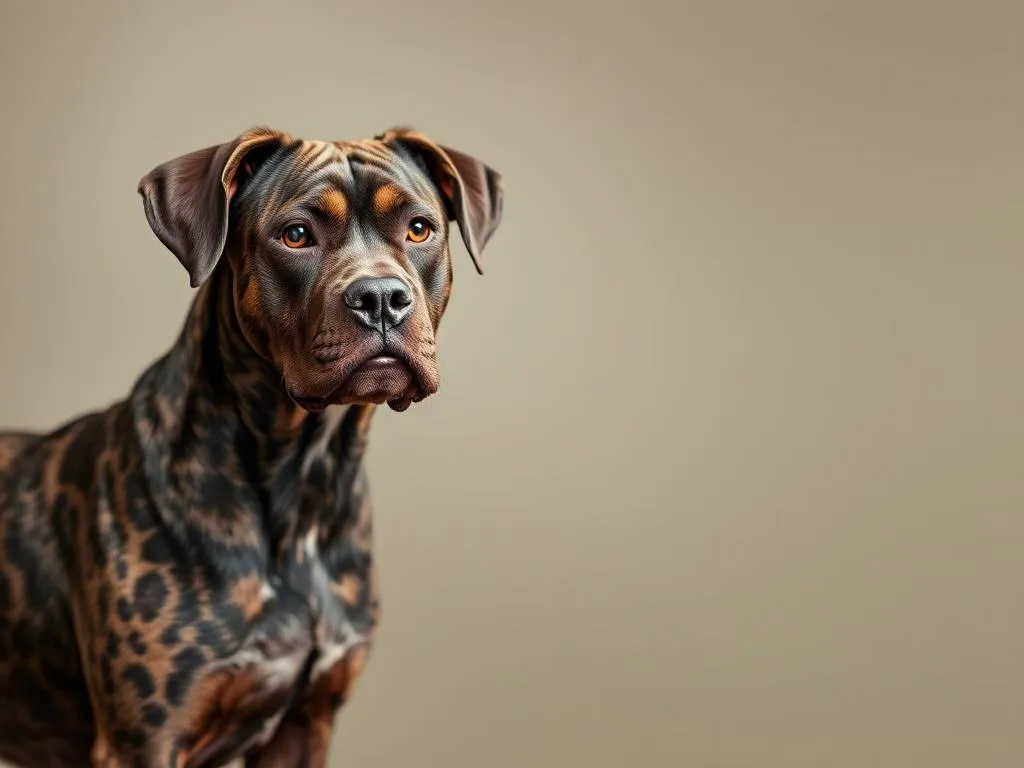
Introduction
The brindle coat pattern is a stunning and unique feature that can be found in several dog breeds. Characterized by a mix of dark and light stripes or swirls, brindle coats add a touch of individuality to any canine. This beautiful coloration is not just a matter of aesthetics; it also has significance in understanding the genetic diversity and breed characteristics. As the pet community grows, so does the popularity of brindle dog breeds, admired not only for their striking appearances but also for their diverse temperaments and personalities. In this exploration, we will delve into the fascinating world of various brindle dog breeds, their traits, and how to care for them.
Understanding Brindle Coat Pattern
What is Brindle?
The brindle pattern is a combination of dark and light stripes that create a marbled effect on a dog’s coat. This pattern can manifest in various animals, but it is particularly popular among dog breeds. The genetics behind the brindle coloration involve a complex interplay of dominant and recessive genes. The primary gene responsible for the brindle pattern is the K locus, which determines the color and distribution of pigments in the dog’s fur.
Variations in Brindle Patterns
Brindle coats can come in an array of shades and patterns. Some common variations include:
- Dark Brindle: Features deep brown or black stripes over a lighter base.
- Light Brindle: Displays softer shades of tan or fawn, often with less contrast.
- Tiger Brindle: Exhibits a more defined striped pattern that resembles a tiger’s coat.
Each brindle dog may showcase a unique pattern, making them distinct and one-of-a-kind in appearance.
Popular Brindle Dog Breeds
American Pit Bull Terrier
The American Pit Bull Terrier is known for its strength, intelligence, and loyalty. This breed often exhibits a striking brindle coat, which adds to its appeal. Generally, they are medium-sized dogs with a muscular build and a playful demeanor.
Common health issues include hip dysplasia and skin allergies, making regular vet check-ups important. When caring for a Pit Bull, ensure they receive proper exercise and socialization to help them thrive as family pets.
Boxer
The Boxer is a playful and energetic breed that makes a fantastic family companion. Their brindle coats can range from light to dark, often with flashy white markings. Boxers are known for their affectionate nature and protective instincts.
This breed typically enjoys a lifespan of about 10 to 12 years but can be prone to certain health issues, such as heart problems and certain cancers. Regular exercise, mental stimulation, and training contribute to a healthy, happy Boxer.
Greyhound
Often thought of as racing dogs, Greyhounds are surprisingly gentle and affectionate pets. Their brindle variations can be striking, showcasing a blend of browns and blacks. Greyhounds are known for their incredible speed and agility but are also quite calm and lazy at home.
Adopting a Greyhound often involves ensuring they are comfortable in a home environment after their racing days. They require moderate exercise and thrive best in homes that can offer them a cozy place to rest.
Mastiffs
Mastiffs are large, powerful dogs known for their gentle demeanor. Several types of Mastiffs, such as the English Mastiff and Bullmastiff, can exhibit brindle patterns. These breeds tend to be calm and protective, making them excellent family guardians.
Due to their size, Mastiffs can be prone to joint issues and heart problems. Regular veterinary visits and a proper diet are essential for maintaining their health.
Whippet
The Whippet is a smaller relative of the Greyhound, known for its speed and grace. Their brindle coats can be quite beautiful, with various shades and patterns. Whippets are affectionate and thrive on companionship.
These dogs require regular exercise but are also content to lounge around the house. Training should focus on positive reinforcement, as they respond well to encouragement.
Dutch Shepherd
The Dutch Shepherd is a versatile working dog known for its intelligence and loyalty. Their brindle variations are particularly striking, often featuring a rich mix of gold and black. This breed excels in various roles, from police work to family companions.
Training a Dutch Shepherd requires consistency and mental stimulation, as they are highly intelligent and eager to learn. Socialization from an early age is vital to ensure they adapt well to various environments.
Staffordshire Bull Terrier
The Staffordshire Bull Terrier is a compact and muscular breed known for its affectionate nature. Their brindle coats are often seen in a variety of shades, making them stand out. Staffies are known for their loyalty and love for children, making them great family pets.
Socialization and training are crucial for this breed, as they can be strong-willed. Regular exercise and mental challenges will help keep them happy and well-behaved.
Characteristics of Brindle Dog Breeds
Temperament
Brindle dog breeds generally exhibit a range of common personality traits. Many are known for their loyalty, intelligence, and playfulness. While coat color does not define behavior, some owners believe that brindle dogs may have a more unique charm due to their striking appearance.
Health Considerations
While brindle coloration itself does not indicate health issues, some breeds may be predisposed to certain conditions. For instance, Pit Bulls can suffer from skin allergies, while Boxers may experience heart-related problems. Regular veterinary care, a balanced diet, and appropriate exercise can help maintain good health.
Lifespan and Aging
The average lifespan of brindle dog breeds varies by breed, typically ranging from 10 to 15 years. Proper care can enhance the quality of life for these dogs. As they age, it’s essential to provide them with a comfortable environment, regular vet check-ups, and a diet tailored to their needs.
Caring for Brindle Dogs
Grooming Needs
Regular grooming is essential for maintaining the health and appearance of a brindle coat. Depending on the breed, grooming needs may vary. Short-haired breeds like Boxers require less grooming, while longer-haired breeds may need more attention.
Recommended grooming tools include:
- Slicker brushes for removing loose fur.
- Bristle brushes for adding shine.
- Nail clippers for regular nail maintenance.
Diet and Nutrition
Each breed has specific nutritional requirements. For instance, larger breeds like Mastiffs may require diets formulated for large dogs to support their joint health. It’s essential to consult with a veterinarian to establish a suitable feeding schedule and diet.
Exercise Requirements
Exercise needs can vary significantly among brindle dog breeds. Generally, active breeds like Greyhounds and Boxers require more vigorous exercise, while others, like Whippets, may enjoy shorter bursts of activity followed by relaxation. Regular walks, playtime, and mental stimulation are crucial for keeping these dogs healthy and happy.
Training Brindle Dog Breeds
Basic Training Techniques
Obedience training is essential for all dog breeds, including brindle ones. Using positive reinforcement methods, such as treats and praise, can effectively teach commands and good behavior. Consistency is key to successful training.
Socialization
Socializing brindle dogs is vital to help them develop confidence and adaptability. Exposing them to different environments, people, and other animals can prevent behavioral issues and promote well-rounded personalities.
Behavioral Issues
Some brindle breeds may face common behavioral challenges, such as stubbornness or anxiety. Early training and socialization, along with patience and understanding, can help address these issues effectively.
Adoption and Buying Brindle Dogs
Where to Find Brindle Dog Breeds
When considering adding a brindle dog to your family, there are various avenues to explore. Shelters and breed-specific rescues often have brindle breeds looking for homes. Reputable breeders can also provide healthy puppies with proper documentation and health clearances.
Questions to Ask Breeders/Rescue Organizations
If you’re adopting or purchasing a brindle dog, it’s essential to ask the right questions to ensure a good fit. Inquire about the dog’s health history, temperament, and any special needs they may have. Understanding their background can help you prepare for a successful transition into your home.
Conclusion
Brindle dog breeds captivate many dog lovers with their unique coat patterns and diverse temperaments. They make wonderful companions, each bringing a distinct personality to their households. Responsible ownership and understanding their needs are crucial for a happy life with a brindle dog. Whether you choose to adopt or buy, the joy of having a brindle breed can be incredibly rewarding.
FAQ Section
What are some common misconceptions about brindle dog breeds?
A common myth is that brindle dogs are more aggressive than other breeds. In reality, temperament is primarily influenced by genetics and training, rather than coat color.
Are brindle dogs more prone to health problems?
Brindle coloration does not inherently cause health issues. However, certain breeds may be predisposed to specific conditions. Regular veterinary care is essential for all dogs.
What should first-time dog owners consider when choosing a brindle breed?
First-time dog owners should research the specific needs and temperament of the brindle breed they are interested in. Understanding grooming, exercise, and training requirements will help ensure a positive experience.









